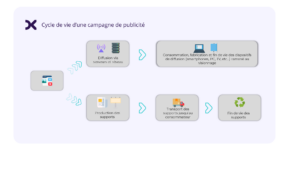Current State of Climate and Environmental Impact Measurement in Advertising

Sylvain Deffay, Senior Manager Media and expert in digital marketing, also leads our Data4Sustainability initiative. Here, he shares the urgency of quickly starting to measure the climate impact of advertising campaigns, whether digital or not.
Key Takeaways:
- The advertising industry is also moving towards a more sustainable world, driven by institutional pressure. It is self-regulating, notably through climate agreements.
- Enacted in 2023, the BEGES decree now requires listed companies to account for indirect emissions (Scope 3) in their carbon footprint. Marketing, which is gaining weight in corporate spending, is not exempt from this new paradigm.
- Accurately measuring the carbon and/or environmental impact of advertising is a challenging task due to the various methodologies, frameworks, media types, and actors in the market.
- Current expertise primarily focuses on measuring the carbon impact of campaigns. Measuring environmental impact, which is both more comprehensive and complex, is still under development.
A Growing Awareness in the Advertising Sector:
In 2021, the Citizens’ Convention for Climate proposed several measures to regulate advertising and advocated for the promotion of virtuous products and initiatives to shift public mindset.
This led to the inclusion in the Climate and Resilience Law of a requirement for certain advertisers to commit, through a “climate contract,” to promoting ecological transition in their commercial communications. Two main areas of improvement are emphasized:
- Promoting new consumption narratives: more sustainable products and services, responsible consumption behaviors (repair, second-hand, etc.).
- Reducing the climate and environmental impact of advertising: from creation to destruction, including dissemination.
The climate contracts naturally align with the carbon trajectories already announced by some companies, whose reporting obligations have been strengthened by two recent regulations. The BEGES decree and the CSRD mandate detailed reporting of greenhouse gas emissions across the supply chain for large corporations.
These constraints raise the question of how to measure the climate impact of communication, particularly in a context where marketing expenditures are increasing within companies(1).
Carbon Emissions or Environmental Impact: Two Distinct Measurement Methods
The first question to address when evaluating media campaigns is the choice of measurement method. Currently, there are two distinct yet complementary approaches:
- The Climatic Approach: This method involves measuring greenhouse gas (GHG) emissions, converting six gases identified by the IPCC into tons of CO2 equivalent (tCO2e) based on their global warming potential. This allows for comparisons. The approach uses the concepts of Scopes 1, 2, and 3 to classify GHG emission sources. Advertising investments fall under an advertiser’s Scope 3, with agencies, creative studios, and media platforms being the main contributors.
- The Environmental Approach: The interprofessional association of media agencies (UDECAM) pioneered the use of the Product Environmental Footprint (PEF) method to measure the environmental impact of advertising campaigns in May 2023. This method goes beyond carbon footprint, assessing 16 different categories of environmental impact. It is the method endorsed by the European Commission for environmental labeling of products and services in the EU, with clothing and food as priority sectors.
Currently, the climatic approach is the most recognized and widely used in the advertising market, as it aligns best with regulations regarding corporate carbon footprint reporting. Specific frameworks have been developed for each advertising channel by interprofessional associations (digital, radio, TV, outdoor advertising, etc.). These various frameworks are unified under the Union des Marques’ One Frame initiative(2).
The environmental approach by UDECAM, though more comprehensive, still has shortcomings, such as the use of averages per channel, which reduces its precision, and a low adoption rate in the market due to its recent introduction.
A More Mature but Still Complex Market
Once the method is chosen, developing a reliable calculator is a complex step, as measuring a media campaign goes beyond just its distribution, as illustrated in the diagram below from the Union des Marques (1):

The construction of an “in-house” tool requires support to select the appropriate measurement reference(s) and to establish regular data reporting intervals.
To address this challenge, SaaS providers and consulting firms have emerged to assist companies in measuring and optimizing the carbon impact of their media campaigns. These actors can be classified into three main categories:
- Measurers: These platforms provide references and databases of emission factors to measure the carbon emissions of an entire campaign’s lifecycle. Their methods are then applied to data they collect or that is provided to them. Measurers can be single-channel (like Impact+) or multi-channel (like Cedara or D-K.io).
- Collectors: These actors, primarily active in the digital space, integrate measurers into their campaign distribution or measurement tools. These services are often billed as an additional CPM on top of media purchases. Examples include a verifier like IAS (in association with Good-Loop) or a DSP & AdServer like Adform.
- Optimizers: Operating at the campaign level, these actors rely on measurers and propose real-time optimization of greenhouse gas emissions. Due to the granularity and immediacy of the data required for their operations, these actors typically operate within the programmatic digital scope. Notable examples include Greenbids and Scibids.
Adding to this varied landscape of actors are further layers of complexity:
- The media types are very different (for instance, the carbon measurement of digital display and video does not relate significantly). It is therefore necessary to standardize everything to a common emission factor (for example, emissions per 1,000 contacts).
- There are no international reference standards, and energy mixes differ by country, complicating measurements at an international level.
The measurement, only a starting point
The measurement of the carbon and environmental impact of advertising is therefore a complex ecosystem. Furthermore, implementing this measurement requires collaboration among several teams: Media (for knowledge of the different channels), Data (for building dashboards and establishing data flows), and CSR (to incorporate the initiative into a broader carbon trajectory). These areas of expertise, which a consulting firm like Converteo is well-versed in, are not always readily available within brands.
However, measurement is just the beginning before facing other challenges, summarized by the ERC sequence (Avoid, Reduce, Contribute):
- Avoid: Modify communication at the source, particularly through the use of Marketing Mix Modeling (MMM) that incorporates a GHG emissions KPI.
- Reduce: When negative impacts cannot be fully avoided, implement optimization strategies for advertising campaigns to minimize them as much as possible.
- Contribute: To sustainably compensate for remaining negative impacts, implement enduring contributory measures to effectively neutralize them.
Currently, all professional associations (Agencies and Media) are active on the subject, but it struggles to reach beyond the first circle of media buying specialists (only 13% of advertisers, compared to 27% of agencies and 32% of adtech, make up the panel for the State of Readiness – Sustainability in Digital Advertising report 2024 from IAB). A movement from both the top and bottom of the market will, however, be necessary for full adoption.
Given this observation, raising awareness and training advertisers on measurement issues seems to be the most effective way to bring the subject to the forefront. That is why cultural acclimatization is, for us, the first step in the overall journey that a marketing department should undertake regarding climate and environmental measurement. Knowing allows for the opportunity to experiment and ultimately choose the most optimal solution(s) for one’s company.
Sources:
(1): https://uniondesmarques.fr/l/library/download/urn:uuid:1b11d1c5-a258-4cf1-b486-86c1ab21523e/07_faire-udm_guide_reduireempreintecarbone_a4-2023.pdf
Contributors : Thomas Mainetti

